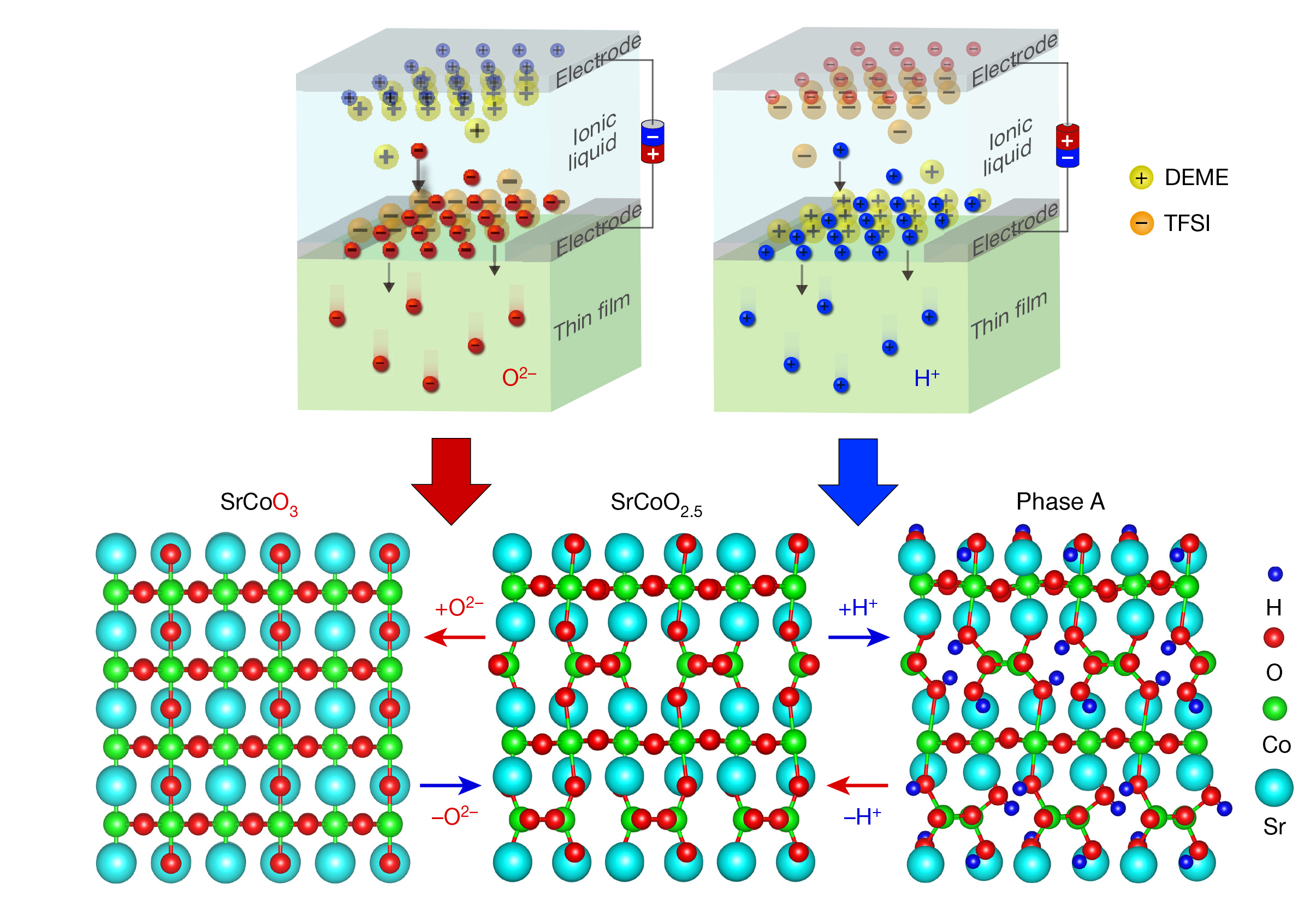With the flip of a switch, three distinct crystalline phases can be induced in one material, with each phase exhibiting very different electronic, magnetic, and optical properties. Materials capable of such versatility are desirable for a wide range of applications, from smart windows and batteries to spintronic devices. In this work, the properties of thin films of strontium cobalt oxide (SrCoOx) were reversibly transformed through the insertion and extraction of oxygen and hydrogen ions, a process controlled by an applied electric field at room temperature. At the ALS, soft x-ray absorption spectroscopy (XAS) and x-ray magnetic circular dichroism (XMCD) experiments were used to verify and clarify the mechanism behind the phase transformations. Overall, the work represents a new approach to the manipulation of material properties that can be readily applied to a broad range of systems.

Earlier studies of ion-mediated phase transformations had focused mainly on the control of one ionic species at a time. In principle, however, increasing the number of ion species could allow access to multiple material phases and functional properties. Moreover, the use of an electric-field switch to drive ion diffusion would allow tunable control of the process and avoid the need for high-temperature thermal annealing. Such an approach had previously been reported for either oxygen or hydrogen ions, but control of both species in one system had not been explored until now.
In this work, the researchers focused on SrCoOx, a simple material known to have at least two crystalline phases: a perovskite phase (SrCoO3−δ, where δ represents oxygen vacancies) and a “brownmillerite” phase (SrCoO2.5). The well-ordered oxygen-vacancy channels in SrCoO2.5 and multivalent cobalt ions were thought to provide favorable conditions for ion-mediated phase transformations.
Thin films of SrCoO2.5 were coated with an ionic liquid—a gel-like layer containing dissociated organic ions (in this case, DEME and TFSI). A voltage applied across the ionic liquid polarized it and drove either oxygen or hydrogen ions (produced by electrolysis of water in the ionic liquid) into the SrCoO2.5. Detailed in situ analyses indicated that the SrCoO2.5 reversibly transformed into two other nonvolatile phases as a function of voltage: SrCoO3−δ upon insertion of O2–, and an unidentified state (Phase A) upon insertion of H+.
To identify Phase A, the researchers performed XAS measurements of cobalt L-edges and oxygen K-edges at ALS Beamline 8.0.1, as well as at synchrotron facilities in Beijing, Shanghai, and Hiroshima. The cobalt spectra correspond directly to cobalt 3d valence states, and a straightforward comparison of the Phase A spectrum with a reference CoO spectrum confirms that the cobalt cations in Phase A are dominated by the +2 oxidation state. Meanwhile, the Phase A oxygen spectrum displays the total suppression of oxygen–cobalt hybridization. This narrowed the identity of Phase A to either SrCoO2 or HSrCoO2.5. Subsequently, based on the above results and a series of other characterizations (scanning transmission electron microscopy, secondary ion mass spectroscopy, and theoretical calculations), Phase A was identified as HSrCoO2.5.

The researchers also brought their samples to ALS Beamline 6.3.1 to perform XMCD measurements. Clear signals for SrCoO3−δ and HSrCoO2.5 and a nondetectable signal for SrCoO2.5 provided solid evidence for changes in magnetic ground states. The rich magnetic phase diagram shows that at room temperature, the transformation between SrCoO2.5 and the other phases is equivalent to turning the antiferromagnetic state on or off. Thus, a new and practical way to achieve electric-field control of antiferromagnetism has been identified. In general, the use of ion transport to change a material’s lattice, orbital, and spin characteristics is very simple and can be readily applied to a wide variety novel materials with exotic functionalities, opening up exciting possibilities for future discoveries.

Contact: Pu Yu
Research conducted by: N. Lu, P. Zhang, H. Li, Y. Wang, J. Guo, D. Zhang, Z. Duan, Z. Li, M. Wang, S. Yang, M. Yan, and C.-W. Nan (Tsinghua University); Q. Zhang (Institute of Physics, Chinese Academy of Sciences; Tsinghua University); R. Qiao, E. Arenholz, and W. Yang (ALS); Q. He (Durham University, UK); S. Zhou and J. Wu (Tsinghua University; Collaborative Innovation Center of Quantum Matter, China); L. Gu (Institute of Physics, Chinese Academy of Sciences; Collaborative Innovation Center of Quantum Matter, China); Y. Tokura (RIKEN Center for Emergent Matter Science, Japan); and P. Yu (Tsinghua University; Collaborative Innovation Center of Quantum Matter, China; RIKEN Center for Emergent Matter, Japan).
Research funding: National Basic Research Program of China, National Natural Science Foundation of China, Tsinghua University, Beijing Advanced Innovation Center for Future Chip, and Chinese Academy of Sciences. Operation of the ALS is supported by the U.S. Department of Energy, Office of Science, Basic Energy Sciences Program.
Publication about this research: N. Lu, P. Zhang, Q. Zhang, R. Qiao, Q. He, H. Li, Y. Wang, J. Guo, D. Zhang, Z. Duan, Z. Li, M. Wang, S. Yang, M. Yan, E. Arenholz, S. Zhou, W. Yang, L. Gu, C.-W. Nan, J. Wu, Y. Tokura, and P. Yu, “Electric-field control of tri-state phase transformation with selective dual-ion switch,” Nature 546, 124 (2017). doi:10.1038/nature22389
ALS SCIENCE HIGHLIGHT #356